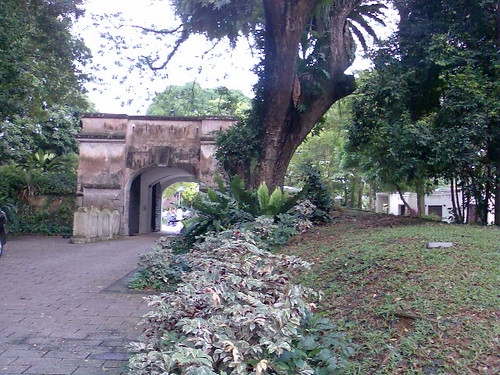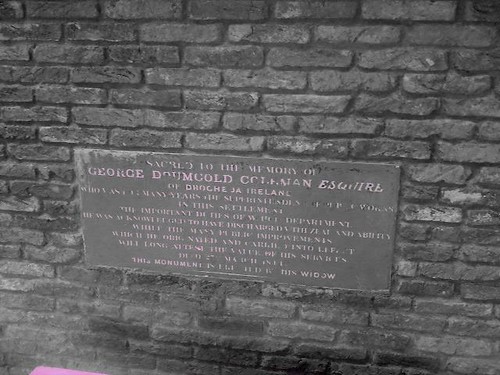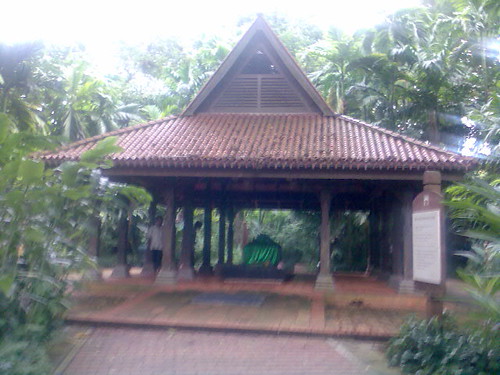
One of my favourite places to visit are old cemeteries, yes, eternal homes, memorial parks [whatever it's called these days], I find it ironic that these places which have markers dedicated for the dead could tell us a lot about life, well, the life lived by its residents that is. In the gravestones that I found, not only contain the usual information we see back home, like, where they were born and date that they died, some of the epitaphs also presented information's on the deceased trade or profession, affiliations, names of their ship, their lineage and other more, it was strange but never the less, very interesting, you're like reading a posthumous resume. Some had more than one language inscribed; it was an impressive memorial considering that most of these gravestones have been around for almost two hundred years.
Established in 1823, the cemetery served mainly Protestants and Catholics. There are two majestic arches that in a way resembles that of the gates of Intramuros, it has the initial IHS, the first three letters of the name Jesus in Greek. In mid 1800's the site no longer could accommodate burials, the cemetery was permanently closed, there were several attempts to have it reopened, however none were authorized. In the 1950's a significant number of gravestones were removed [to free up space?], the few remaining stone memorials where fixed to the cemetery walls.
Today, one could enjoy a leisurely walk in this peaceful nature park while enjoying the natural scenes and viewing the old tombstones. It was a cloudless afternoon, the sun was exposed, but the trees were countless, they kept the place cool and misty. Up in the hill, behind the elevated white hill house, which looks like the Malacanan from a distance [now cultural theatre and venue], I witnessed a regal wedding in an area that call to mind our charming Paco cemetery [now also a park], they were the moneyed class here [mga mapera!] all the parked cars on the cemented pavement were luxury cars [cars that I usually see on posters with half naked female models], everything looked extravagant, I hang around for awhile and listened to an acoustic duo that serenaded the newlyweds.
One of the famous residents of the this old Christian cemetery is George Coleman [not Foreman the boxer], the famed Irish architect, credited to have given Singapore its first beautiful buildings, like the first Government house, St. Andrews, Parliament, Raffles Institute and the Armenian Church. He also built this structures called Cupolas, right in the middle of the cemetery, probably a place built as a shed but it's too small and could only accommodate few people, maybe two - I believe that this structures where built for the spirits [his and his wife] its an odd structure, this is the first time I've seen one.
Coleman would be Burnham to Singaporeans, he's credited to have given Singapore its true English buildings. It was said that the first Catholic Church in Singapore was originally designed by him; however, it was not approved because of financial issues.

Coleman was also commissioned by Raffles to several jobs including overseeing convict labours and surveying the many islands, but he's best remembered for his contribution in architecture. His tombstone was dedicated by his wife, it was an impressive and very well made gravestone, the Singapore historical commision as placed a metal marker, so people could easily spot the grave. Mrs. Coleman would later marry a man named James Napier, said to be the first Law agent in the straits settlements, she would dedicate another grand memorial tomb here later on, but this time to her son with Napier, James Brooke Napier , their prominence can be seen in the graceful memorial head stones that still stands in the cemetery hill.

Coleman's house [the street was renamed after him] , which is near the old cemetery was converted into a hotel long after he died, it is now where the Peninsula hotel stands. The Coleman house could be the hotel where Rizal stayed, however, I could not find anything that could substantiate this, although I'm certain that the area where Peninsula hotel now is where Rizal's Hotel de la Paix was located. Whether it was Coleman's house that became the hotel later on is still a question to me, I have yet to see a map or something to find out if they were the same.
Somewhere in the hill, I stumbled upon a small house made of solid timber, there was a centrepiece that was covered in silky clothe, it was adorned with fresh flowers and some fragrant object, the place is said to be the final resting place of the last king of Malaya, he was a Muslim Rajah, the Malay people revered him. I saw there some people cleaning the wooden floor. The house is traditionally built like the wooden houses that can be found in Mindanao. The place is known to Malay as Bukit Larangan, the word Bukit is where our Bukid originated, Larangan to Malay is forbidden, for us I believe it means 'field'. For years they have considered the hill a no entry zone, of course when the British came that all changed. Raffles built his house on the hill, he once wrote a friend that he would not mind being buried alongside the Malayan king, however, it is yet unproven if the great Rajah was indeed buried on his hill, since it was recorded that he died in Malaca. There were an excavation that was carried out and they had found eveidence that could prove that the hill was the site of Iskandar Shah.

I saw people cleaning the wooden house, scrubbing it [binubunot] they must be the assigned cleaners, which reminds me of my grade school years where school children were assigned to be cleaners depending on the day, mine is usually Monday since my last name start with an A. The wooden house has striking similarity to the Mindanaoan wooden houses, it was humble yet poetic, it has a pointed edge on its roof, it's open on all sides and there were people kneeling on its hard wood parquet. I did not bother to enter and take pictures; I don't want to disturb what there were doing inside. I took a picture from a distant and moved on.
There is so much to see in this hill, there's a botanical garden, it has hundreds of plants with name plates on it. It was said that Raffles also had ordered spices to be planted for studies and future plans of making them steady agricultural produce. Unlike Magellan or Legazpi, who has been succesfully demonized in our popular history, this man Raffles seems to enjoy a rock star stature here, he's regarded as the founder of the modern Singapore, when he claimed the island for the English empire. One could go around his garden and find exotic plants, plants that I have never seen even in books, I did however found Kamias, I wanted to take some home for sinigang but I decided not to, I might get fined, they don't call this country the Fine city for nothing. Sinigang by the way is Malay in origin.
I noticed a tombstone that I believe belongs to an Armenian, on it, the birthplace written was "Manila", Filipinos had great ports then in Spanish Manila - migration was extensive even then. Another had the Masonic emblem on it, actually I've seen several around - they must've been really devout and proud members of that secret society. I also saw Star of David symbol, turns out that they had a healthy Jewish population then, Jewish were very influential in the islands - I remember this ambassador to France, I believe he was Singapore's first non Oriental high ranking diplomat. I also discovered interesting are the angels carved in marbles, they were like jewels, they look as if they have just been made recently.
There was this tombstone that was dedicated by the officers and crew member of a US Navy ship, they probably buried their fallen comrade here for practical reasons, a voyage back to midland US is a distant transit, so he was laid to rest here in a tropical island. Everywhere I find curious epitaphs, some had expressive verses, other were plain, providing only the names and life in years.
Even on a hot day, the climate remained cool, thanks to the rainforest like vegetation, I stayed in the area for three hours, wandering around and occasionally taking breathers in between, hiding beneath the shades of the hills mighty trees. I'm sure going to look for old burial places back home, who's with me?



No comments:
Post a Comment